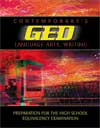| Two readers should read each GED essay. Each reader rates the paper according on the four-point holistic grading scale, with 1 (inadequate) being the lowest and 4 (effective) being the highest. Then the two readers' scores are averaged to produce a final score for the essay. If the two readers have a wide discrepancy between their scores, a third reader can be used to settle the disagreement.
The GED essay score will represent 37 to 40 percent of the total score on the GED Language Arts, Writing Test. The remaining part of the score is from the multiple-choice portion. However, the minimum passing score on the essay part of the test is a 2. If a score is lower than 2, the student will have to take both parts of the Language Arts, Writing Test again regardless of the score on the multiple-choice part of the test.
Before scoring a GED essay, each reader should become familiar with the GED Essay Scoring Guide. Read through it carefully to gain an overall impression of what is required for each of the four possible scores. Use the Sample Essays with their accompanying scores and explanations to familiarize yourself with the guidelines in the scoring rubric.
As you read an essay, follow these guidelines: - Read for an overall impression of the essay. You should spend no longer than 1 or 2 minutes per essay. Avoid the tendency to mark each error or to write corrections. Poor grammar or spelling should lower a score only when it interferes with the overall effectiveness of the essay.
- Refer to the standards on the GED Essay Scoring Guide frequently so that you do not score an essay by comparing it to another one you've just read.
- You may have high, medium, or low essays within each score. In other words, you may read a high 2 that doesn't have all the qualifications to be a 3. Or you may read a low 3 that meets all the requirements for a 3, but just barely.
- Don't make assumptions or fill in ideas for the writer. If it's not written in the essay, it can't be scored. Score only what is on the pages.
- Be sure that you are not biased by
- the neatness or messiness of the handwriting
- narrow-margined, cramped writing or wide margined, spacious writing
- the tone that the writer uses
- the opinions that the writer expresses
- your own pet peeves, such as using "etc." or "a lot"
- Remember that the writer had only 45 minutes to brainstorm or organize thoughts, write a draft, and edit the draft. You should not expect a flawless, polished essay.
- The essay does not have a required number of words or pages. However, it should be long enough to explain the writer's ideas adequately.
|



 2002 McGraw-Hill Higher Education
2002 McGraw-Hill Higher Education